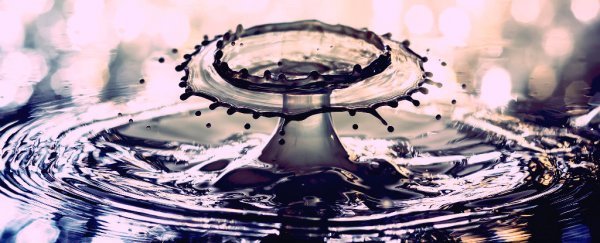There's some complex science behind a simple water splash, but scientists now think they're closer than ever to understanding what happens during a splash at the microscopic level.
A new mathematical model shows how incredibly thin layers of air on surfaces can cause upward splashes from water droplets thousands of times larger, with air pressure and viscosity also affecting the chances of a splash.
In fact, these air layers are so thin, they're the equivalent of a 1 cm-thick (0.39 inch) layer of air stopping a tsunami wave as it hits a beach, according to mathematician James Sprittles from the University of Warwick in the UK.
The model suggests that a microscopic layer of air just 1 micron in size – 50 times smaller than the width of a human hair – is enough to get in the way of a 1-millimetre (0.039-inch) water droplet and cause it to splash up, rather than spread out evenly across a surface.
"The air layer's width is so small that it is similar to the distance air molecules travel between collisions, so that traditional models are inaccurate and a microscopic theory is required," explains Sprittles.
 Animation showing the model in action. Credit: University of Warwick
Animation showing the model in action. Credit: University of Warwick
While the idea of air layers affecting splashes has been suggested before, the new model goes into greater detail to explain what's happening at the smallest scale as the air and liquid interact under different circumstances.
One such circumstance is at the top of mountains, where air pressure is lower and splashes are less likely to occur, because the air can more easily escape from under the liquid.
But the benefits of this kind of research go way beyond helping mountaineers predict whether their split drinks are going to cause splashback.
Understanding how and why splashes occur could benefit researchers in everything from analysing blood spatter at a crime scene to knowing exactly what speed to spray fertiliser on plants to avoid splash-back.
"Most promisingly, the new theory should have applications to a wide range of related phenomena, such as in climate science," says Sprittles, "to understand how water drops collide during the formation of clouds or to estimate the quantity of gas being dragged into our oceans by rainfall."
As previous research has shown, even the temperature of water can change how it splashes around, and Sprittles says combining his new hypothesis with existing models shouldn't be too difficult.
The next step is to build more complex models on top of this basic framework, and then we'll have an even better ability to predict what kind of splashes will occur in different kinds of circumstances.
"You would never expect a seemingly simple everyday event to exhibit such complexity," Sprittles says.
The research has been published in Physical Review Letters.
